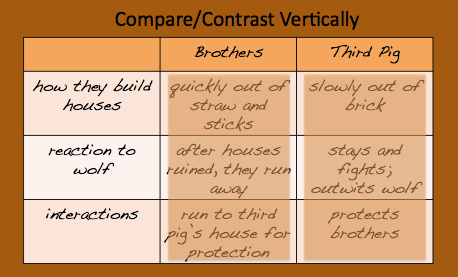Fourth grade marks the beginning of CCRA.W.9. This tells us that students in Grade 4 and beyond are expected to construct defensible responses related to all Reading: Literature and Reading: Informational Texts standards. Skills at each grade level build on previous years, but what must fourth and fifth graders do? Let's examine the standards to find out.
Grade 4 Standards
W.4.9a: Apply grade 4 Reading standards to literature (e.g., "Describe in depth a character, setting, or event in a story or drama, drawing on specific details in the text...")
While this is a blanket statement, I interpret this to mean that students in fourth grade must respond to a prompt asking them to demonstrate that they can:
- RL.4.1 - answer explaining and inferring questions; cite
- RL.4.2 - determine theme and summarize
- RL.4.3 - describe a character, setting, or event
- RL.4.5 - explain differences between poems, drama, and prose
- RL.4.6 - compare and contrast point of view
- RL.4.7 - make connections between stories and their visual or oral presentations
- RL.4.9 - compare and contrast treatment of similar themes, topics, and patterns of events
W.4.9b: Apply grade 4 Reading standards to informational text (e.g., "Explain how an author uses reasons and evidence to support particular points in a text.")
Similarly, when reading informational texts, they must respond to prompts asking them to:
- RI.4.1 - answer explaining and inferring questions; cite
- RI.4.2 - determine main idea and summarize
- RI.4.3 - explain events, procedures, ideas, or concepts
- RI.4.5 - describe overall structure
- RI.4.6 - compare and contrast firsthand and secondhand accounts
- RI.4.7 - interpret information presented visually, orally, or quantitatively
- RI.4.8 - explain how an author uses reasons and evidence
- RI.4.9 - integrate information from two texts
Here's a simple example that goes with RL.4.3:
W.5.9a: Apply grade 5 Reading standards to literature (e.g., "Compare and contrast two or more characters, settings, or events in a story or a drama, drawing on specific details in the text...")
- RL.5.1 - answer explaining and inferring questions; quote
- RL.5.2 - determine theme and summarize
- RL.5.3 - compare and contrast two characters, settings, or events
- RL.5.5 - explain how chapters, scenes or stanzas fit together
- RL.5.6 - explain how a narrator's point of view influences how events are described
- RL.5.7 - analyze how visual and multimedia elements contribute to meaning
- RL.5.9 - compare and contrast stories in the same genre
- RI.5.1 - answer explaining and inferring questions; quote
- RI.5.2 - determine two or more main ideas and explain their key details; summarize
- RI.5.3 - explain relationships/interactions between individuals, events, ideas, or concepts
- RI.5.5 - compare and contrast structure of two or more texts
- RI.5.6 - analyze multiple accounts of the same event or topic, noting similarities and differences
- RI.5.7 - draw information from multiple print or digital sources
- RI.5.8 - explain how an author uses reasons and evidence
- RI.5.9 - integrate information from several texts
One helpful structure is the comparison table (which I've mentioned in previous posts). Let's take a look at how this graphic organizer works for RL.5.3.
Students would compare certain aspects of the characters, including their interactions (which is mentioned in the standard), on a table. To construct their responses, students would either write horizontally or vertically, as shown below. Horizontal writing would feature each aspect while vertical writing would feature each character.
In this simple example, a single-paragraph response may be possible, but for most real-world prompts, multiple paragraphs would be necessary. For the horizontal example, students would write an introductory paragraph, three supporting paragraphs (one for each row), and a concluding paragraph. The vertical example would include an introductory paragraph, two supporting paragraphs (one for each column), and a concluding paragraph. You can see that fifth grade students are getting to the point where writing thesis statements needs to be introduced.
Yes, here it is. The big Common Core test prompt standard. Writing Standard 9 explains expectations for reading test questions. Let's roll up our sleeves and get started!







No comments:
Post a Comment